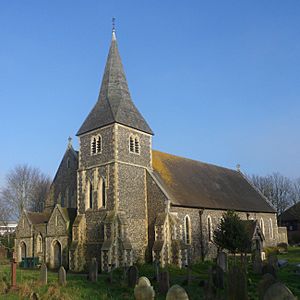St Leonard's Church, Aldrington facts for kids
Quick facts for kids St Leonard, Aldrington |
|
|---|---|

The church from the southwest
|
|
| 50°49′58.58″N 0°12′13.56″W / 50.8329389°N 0.2037667°W | |
| Denomination | Church of England |
| History | |
| Dedication | Saint Leonard of Noblac |
| Administration | |
| Parish | Aldrington, St Leonard |
| Deanery | Rural Deanery of Hove |
| Archdeaconry | Archdeaconry of Brighton & Lewes |
| Diocese | Chichester |
| Province | Canterbury |
St Leonard's Church is an Anglican church located in Hove, a city in England. It stands on New Church Road in the Aldrington area. Aldrington used to be a separate village. This church serves as Aldrington's main parish church. The road it is on was renamed New Church Road because another church, St Philip's, started being built nearby in 1894.
Contents
History of St Leonard's Church
Aldrington was a small village during the Middle Ages. It was located between Hove to the east and Portslade to the west. Over time, the River Adur changed its path. This caused the village's population to shrink.
Early Decline and Ruins
The Great Storm of 1703 damaged many homes. This made the population decline even faster. By 1800, no one lived in Aldrington anymore. A mediaeval parish church, built in the 13th century, stood in the village. It had a tower, a chancel (the area around the altar), and a nave (the main part of the church).
This old church started to fall apart in the 1500s. By 1638, it was in ruins. Its walls completely collapsed soon after 1800.
Aldrington's Revival and New Development
In the 1800s, Hove grew very quickly. As more people needed homes, development spread westwards. Church Road, a main route, was extended into Aldrington.
From 1875 onwards, all the land south of Church Road was built up with houses. The opening of Aldrington railway station also helped the area grow. In 1893, Aldrington officially became part of Hove. The next year, part of Church Road was renamed New Church Road. This happened after plans for St Philip's Church were approved.
Rebuilding the Church
St Leonard's church remained a ruin until 1878. Architects Richard Herbert Carpenter and Benjamin Ingelow were chosen to rebuild it. They used parts of the old tower and south aisle in their new design.
The new church looked like the mediaeval style. It featured lancet windows (tall, narrow windows) and knapped flintwork (a way of shaping flint stones). The new tower was built with six bells.
Later Expansions and Features
Another big rebuilding project happened in 1936. This was done to make the church bigger. Harold Milburn-Pett, an architect for the Diocese of Chichester, led this work. The church was made much wider. The original nave became an aisle, and a new nave and chancel were built on the north side.
A northern aisle was planned but never added. Because of this, the northern outer wall of the church looks different. It is made of red brick instead of knapped flint. In the same year, a spire (a tall, pointed roof) was added to the tower for the first time.
New lancet windows were put in after World War II. A lychgate (a covered gateway to a churchyard) was also added on the southern side. In 1950, the church was given a Grade II listing. This means it is an important building with special historical interest.
Notable Burials
The ashes of actor C. Aubrey Smith are buried in his mother's grave in the churchyard. The churchyard also has a Commonwealth War Grave from 1917.
The Parish of St Leonard's
The area served by the parish of St Leonard's covers Aldrington. It includes all the homes within certain boundaries. These boundaries are Wish Road, the sea, Boundary Road/Station Road, and the railway line. The parish also extends north of the railway to include all of Hove Cemetery. This cemetery first opened in 1882. It was later made larger by using the land where the Devil's Dyke Railway used to be.
See also
- Grade II listed buildings in Brighton and Hove: S
- List of places of worship in Brighton and Hove

